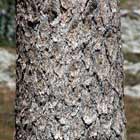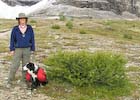
1. Larches and campfire smoke in meadow, Upper Larch Lake, Washington [C.J. Earle, 2004.10.03].

2. Long shoot on a sapling [C.J. Earle, 2003.08.17].

3. Autumn foliage on short shoots [C.J. Earle, 2004.10.03].

4. Seed and pollen cones [C.J. Earle, 2003.08.16].

5. Bark of a tree about 20 cm diameter [C.J. Earle, 2003.08.17].

6. Bark on a large tree growing amidst krummholz Abies lasiocarpa var. bifolia [C.J. Earle, 2004.10.03].

8. Landscape distribution of the species is easy to see in the fall. Upper Larch Lake basin [C.J. Earle, 2004.10.03].

9. Stand of trees near Mt. Temple, Alberta [C.J. Earle, 2004.09.05].

10. Autumn scene at Upper Larch Lake [C.J. Earle, 2004.10.02].

11. Krummholz, Sentinel Pass, Alberta [C.J. Earle, 2004.09.05].

12. Young trees invading a subalpine meadow at Lower Larch Lake [C.J. Earle, 2004.10.02].

13. A seedling, about 20 cm tall, growing in Cassiope heather [C.J. Earle, 2005.08.28].

14. The largest known tree [C.J. Earle, 2004.10.03].

Conservation Status

Larix lyallii
Parlatore 1863
Common names
Alpine larch, mountain larch, tamarack (Peattie 1950); mélèze de Lyall [French] (Parker 1993).
Taxonomic notes
Larix lyallii and L. occidentalis (Larix sect. Multiseriales) are similar morphologically and have similar geographic ranges. Just how closely the two species are related has not been determined, but they probably originated from a common ancestor resembling L. potaninii Batalin (Parker 1993). They may hybridize where their ranges overlap (Parish et al. 1996).
First described by Scots naturalist David Lyall in 1858 (Parish et al. 1996).
Description
Trees to 25 m tall with dbh to 120 cm; crown sparse, conic to irregular. Bark thin, smooth, yellowish grey when young; becoming furrowed and flaking into red- to purple-brown scales with age. Branches horizontal, occasionally pendulous, often gnarled and irregularly spaced, persistent on trunk when dead; twigs strongly white- to yellow-tomentose for 2-3 years. Buds tomentose, scale margins ciliate. Needles deciduous, in bunches of 30-40 on short shoots 20-35×0.6-0.8 mm, 0.4-0.6 mm thick, keeled abaxially, 2-angled adaxially, light green, turning golden yellow in autumn; resin canals 40-80 µm from margins, each surrounded by 6-10 epithelial cells. Ovulate cones elliptic, upright, red when young, turning purplish and then brown with age, 2.5-4(5)×1.1-1.9 cm, on curved stalks 3-7×2.5-4 mm; scales 45-55, rounded, margins erose, abaxial surface tomentose at maturity; bracts tipped by awn 4-5 mm, exceeding mature scales by ca. 6 mm. Pollen 78-93 µm diam. Seeds yellow to purple, body 3 mm, wing 6 mm (Parker 1993, Parish et al. 1996). See García Esteban et al. (2004) for a detailed characterization of the wood anatomy.
Photos at right illustrate some of the major identifying features. Photo 2 shows an actively growing shoot on a sapling at Hart's Pass, North Cascades. The long shoot, about 10 cm long, has emerged this year and is near full elongation at this time, about 75% of the way through the growing season. The short shoots at its base show whorls from two (lateral buds) or three (terminal bud) years of prior growth. Photo 3 is taken in the autumn, when the foliage has turned golden yellow and is ready to fall. It shows leaves emerging from short shoots. Photo 4 shows mature seed and pollen cones. Photos 5 and 6 show bark on, respectively, a fairly young tree and a much older tree that is bearing epicormic branches. Photo 13 shows a seedling several years old.
Distribution and Ecology
Canada: Alberta and British Columbia; USA: Washington, Idaho and Montana at 1800-2400 m (Parker 1993). See also Thompson et al. (1999). Hardy to Zone 3 (cold hardiness limit between -39.9°C and -34.4°C) (Bannister and Neuner 2001).
See photos at right. It is locally common on exposed northern subalpine slopes to timberline, often with very rocky soils, as seen in photos 8, 9 and 10. It has very low shade tolerance and, due to its thin bark, low fire tolerance (Parish et al. 1996). Its deciduous habit confers resistance to winter desiccation, permitting this species to reach timberline elevations that may be far above other conifers, and to retain an erect growth form on those sites; photo 6 shows erect trees growing over Abies lasiocarpa var. bifolia krummholz. Nonetheless, as shown in photo 11, it can form a krummholz in very extreme settings; the trees shown are in a recently deglaciated area near Sentinel Pass, Alberta. Despite its tolerance of harsh mountain environments, the species can occur and compete effectively with evergreen conifers on fairly good sites within its range. Photo 10 shows the landscape-scale distribution of trees in Larch Lakes Basin, where the largest and tallest known alpine larches grow. Besides occurring on rocky talus and exposed bedrock, larch in this setting also occurs on colluvial hillslope soils and on deep alluvial soils around the lakes, in the company of Abies lasiocarpa, Picea engelmannii, and even a few Tsuga mertensiana. On the rocky ridges here, it also grows with Pinus albicaulis (pers. obs. 1986-2012).
Although the geographic ranges of Larix lyallii and L. occidentalis overlap considerably, elevational differences of 150 to 300 m usually separate them. Some morphologically intermediate specimens have been collected from Washington and Montana (Parker 1993).
Distribution data including polygons provided by USGS (1999) and my personal observations through 2017. Green is Larix lyallii; red is L. occidentalis.
Remarkable Specimens
Both the largest and the tallest trees ever measured are at Larch Lakes, Washington. I found the big tree in 1993, but didn't return to get accurate measurements until Bob Van Pelt and I visited the site in October, 2004 (photo at right). The big tree was 215.1 cm DBH, 31.3 m tall, with a crown diameter of 18.0 m. It was remeasured in 2017; at that time it was 216.7 cm dbh, 31.7 m tall, with a 22.9 m crown, and still in excellent health. The tall tree was in a closed-canopy stand of very tall trees west of the upper lake, in the company of many comparably tall trees; it was 38.5 m tall and 101.0 cm dbh in 2004.
The current record age record is sample BAL091 from a tree collected near Baker Lake, Montana in 1997 by Malcolm Hughes, Connie Woodhouse and Peter Brown. This sample starts in 987 and ends in 1997 for a total history of 1,011 years, verified by crossdating (NCDC 2008). Other old tree records include:
- Margaret Colenutt collected a sample with 838 rings near Waterton, BC; most or all of this is a crossdated age (Luckman 2006).
- A ring-counted age of 791 years for sample COL-6A collected from a stand above Colchuck Lake in the Alpine Lakes Wilderness of WA by C.J. Earle in 1986. This is a pith date, but on a scarred core that may be missing some rings in the early 1300s. The tree was only about 40 cm diameter at the core height, a fine illustration of the rule-of-thumb that exceptionally old trees tend not to be particularly large ones.
- A crossdated age of 728 years for a specimen from W Alberta collected by B.H. Luckman (Brown 1996). I believe this is from a living tree, collected in the late 1980s or early 1990s.
Ethnobotany
Due to its small size and remote occurrence, its principal values are scientific and aesthetic. Few trees are lovelier, either in spring when the soft green of the needles contrasts with deep snowdrifts still covering the ground in this species' alpine habitat, or in autumn, when its golden foliage complements the red of huckleberries and the icy blue of the sky. Many dendrochronological collections have been made in the North Cascades of Washington and the Canadian Rockies, e.g., Colenutt and Luckman (1991).
Observations
Many very fine stands are to be found in the eastern Cascade Mountains, including the Alpine Lakes, Glacier Peak and Pasayten Wildernesses, North Cascades National Park (WA), and Manning Provincial Park (BC). It is also widespread and exemplary in much of the Canadian Rockies, such as in Banff National Park.
Remarks
Mountain goats, bighorn sheep and black and grizzly bears all feed in alpine larch stands. Blue grouse feed on the needles (Parish et al. 1996).
Citations
Colenutt, Margaret E. and Brian H. Luckman. 1991. Dendrochronological investigation of Larix lyallii at Larch Valley, Alberta. Canadian Journal of Forest Research 21: 1222-1233.
Luckman, B.H. 2006. Current research. http://geography.uwo.ca/facilities/dendro/tree-ring-research.pdf, accessed 2007.10.22.
National Climate Data Center [NCDC]. 2008. Tree-Ring Data Search Results, Baker Lake (USA; 45N,114W; Hughes,M.K.;Woodhouse,C.A.;Brown,P.M.). http://hurricane.ncdc.noaa.gov/pls/paleo/fm_createpages.treering, accessed 2008.07.25, now defunct.
Parlatore, F. 1863. Coniferas novas nonnullas descripsit, Florence (pp. 1-4).
See also
Arno, Stephen F. and James R. Habeck. 1972. Ecology of alpine larch (Larix lyallii Parl.) in the Pacific Northwest. Ecological Monographs 42(4):417-450.
Bakowsky, O. A. 1989. Phenotypic variation in Larix lyallii and relationships in the larch genus. M.Sc.F. thesis. Lakehead University.
Burns and Honkala (1990).
Carlson (1965).
Carlson et al. (1991).
Elwes and Henry 1906-1913 at the Biodiversity Heritage Library (Photo). This series of volumes, privately printed, provides some of the most engaging descriptions of conifers ever published. Although they only treat species cultivated in the U.K. and Ireland, and the taxonomy is a bit dated, still these accounts are thorough, treating such topics as species description, range, varieties, exceptionally old or tall specimens, remarkable trees, and cultivation. Despite being over a century old, they are generally accurate, and are illustrated with some remarkable photographs and lithographs.
FEIS database.
Knudsen (1968).
Owens and Simpson (1986).













